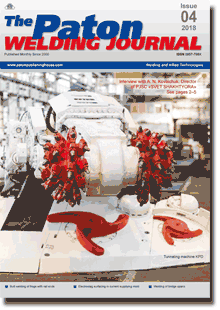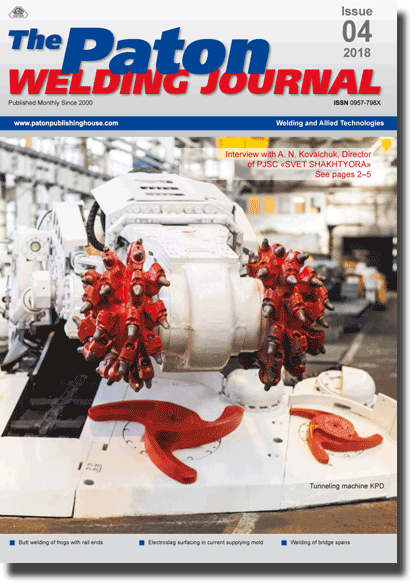| 2018 №04 (07) |
DOI of Article 10.15407/tpwj2018.04.08 |
2018 №04 (01) |

The Paton Welding Journal, 2018, #4, 39-41 pages
Application of non-conducting consumable billets at electroslag surfacing in current-supplying mould
Yu.M. Kuskov, V.G. Soloviov, P.P. Osechkov and V.A. Zhdanov
E.O. Paton Electric Welding Institute of the NAS of Ukraine 11 Kazimir Malevich Str., 03150, Kyiv, Ukraine. E-mail: office@paton.kiev.ua
Abstract
The effect of increasing the distance from the processed surface to the current-conducting section of the current-supplying mould on base metal penetration, deposition rate and specific power consumption was studied at electroslag surfacing of end faces with application of non-conducting billets. Comparison of this effect on the quality of bimetal produced in electroslag surfacing with electrodes and non-conducting billets of the same cross-section was performed. It is found that application of optimal electric power to the slag pool through current-conducting section of current-supplying mould and of consumable billets allows achieving the set penetration of base metal, good formation of the deposited layer and process efficiency, commensurate with those obtained at surfacing with electrode of the same cross-section, only in the case of optimum distance from the melted edge of the consumable billet to the processed surface of the item. 13 Ref., 1 Table, 2 Figures.
Keywords: electroslag surfacing of end faces, non-conducting large-section consumable billet, current-supplying mould, power sources, processed surface, base metal penetration, surfacing quality
Received: 15.11.17
Published: 11.04.18
References
- Artamonov, V.L., Sushchuk-Slyusarenko, I.I. (1988) Electroslag surfacing. Svarka, 11, 41–46 [in Russian].
- Benua, F.F., Katler, A.I. (1960) Technical-economic indexes of melting in automatic slag welding with plate electrode. , 10, 19–22 [in Russian].
- Yakushin, B.F., Bashev, L.F. (1982) Study of the electroslag welding with filler metal. Vuzov, 7, 97 [in Russian].
- Yakushin, B.F., Bashev, L.F., Tikhonov, V.P. et al. (1989) Improvement of technological strength of welded joint in electroslag welding. Svarka, 10, 51 [in Russian].
- Sushchuk-Slyusarenko, I.I., Shabalin, N.N., Andrianov, G.G. et al. (1974) Some means for improvement of electroslag welding efficiency. Ibid., 2, 46–48 [in Russian].
- Gulida, V.P., Semenov, V.M., Yakovleva, L.I. et al. (1987) Electroslag welding with additional filler wire of parts from 09G2S steel of 60-140 mm thickness. Proizvodstvo, 2, 15–18 [in Russian].
- Burkatsky, A.A., Durkin, V.E., Sushchuk-Slyusarenko, I.I. (1984) Electroslag welding with additional flux-cored wire feed. Svarka, 6, 67 [in Russian].
- Medovar, B.I., Saenko, V.Ya., Nagaevsky, I.D. et al. (1984) Electroslag technology in mechanical engineering. Kiev, Tekhnika [in Russian].
- Ponomarenko, V.P., Stojko, V.P., Valits, K.A. et al. (1988) Electroslag surfacing using consumable and nonconsumable electrodes. In: Theoretical and technological principles of surfacing. Surfacing in metallurgical and mining industries. Kiev, PWI, 30–32 [in Russian].
- Ermantraut, M.M., Malimonov, V.I. (1968) Application of nonconsumable electrode in electroslag surfacing. Proizvodstvo, 2, 16–18 [in Russian].
- Kuskov, Yu.M., Soloviov, V.G., Zhdanov, V.A. (2017) Electroslag surfacing of end faces with large-section electrode in current-supplying mould. The Paton Welding J., 12, 29–32. https://doi.org/10.15407/tpwj2017.12.05
- Kuskov, Yu.M., Soloviov, V.G., Osechkov, P.P. et al. (2018) Electroslag surfacing of billet end faces with application of consumable and nonconsumable electrodes. Ibid., 2, 38–41. https://doi.org/10.15407/tpwj2018.02.08
- Kuskov, Yu.M., Soloviov, V.G., Osechkov, P.P. et al. (2018) Electroslag surfacing with large-section electrode at direct current in current-supplying mould. Ibid., 3, 32–35. https://doi.org/10.15407/tpwj2018.03.07
Suggested Citation
Yu.M. Kuskov, V.G. Soloviov, P.P. Osechkov and V.A. Zhdanov (2018) Application of non-conducting consumable billets at electroslag surfacing in current-supplying mould. The Paton Welding J., 04, 39-41.The cost of subscription/purchase order journals or individual articles
| Journal/Currency | Annual Set | 1 issue printed |
1 issue |
one article |
| TPWJ/USD | 384 $ | 32 $ | 26 $ | 13 $ |
| TPWJ/EUR | 348 € | 29 € | 24 € | 12 € |
| TPWJ/UAH | 7200 UAH | 600 UAH | 600 UAH | 280 UAH |
| AS/UAH | 1800 UAH | 300 UAH | 300 UAH | 150 UAH |
| AS/USD | 192 $ | 32 $ | 26 $ | 13 $ |
| AS/EUR | 180 € | 30 € | 25 € | 12 € |
| SEM/UAH | 1200 UAH | 300 UAH | 300 UAH | 150 UAH |
| SEM/USD | 128 $ | 32 $ | 26 $ | 13 $ |
| SEM/EUR | 120 € | 30 € | 25 € | 12 € |
| TDNK/UAH | 1200 UAH | 300 UAH | 300 UAH | 150 UAH |
| TDNK/USD | 128 $ | 32 $ | 26 $ | 13 $ |
| TDNK/EUR | 120 € | 30 € | 25 € | 15 € |
AS = «Automatic Welding» - 6 issues per year;
TPWJ = «PATON WELDING JOURNAL» - 12 issues per year;
SEM = «Electrometallurgy Today» - 4 issues per year;
TDNK = «Technical Diagnostics and Non-Destructive Testing» - 4 issues per year.


